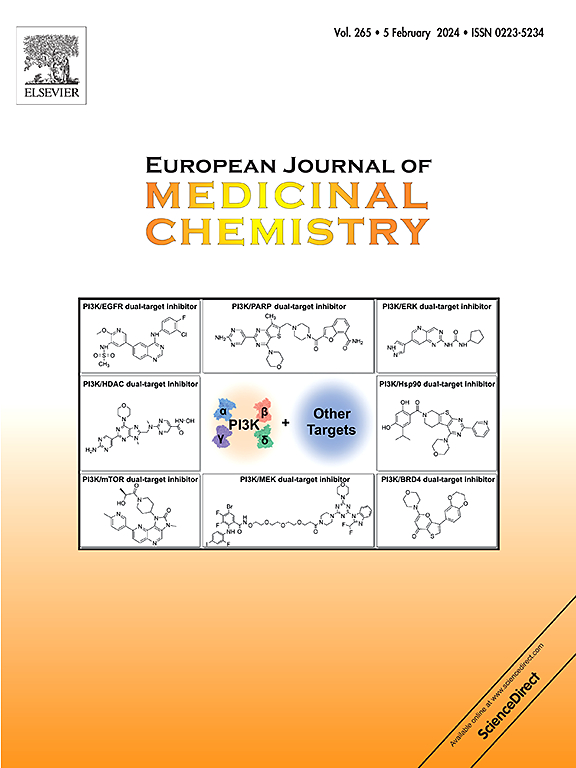代谢性谷氨酸受体5在抑郁症中的作用:机制和治疗潜力
IF 6
2区 医学
Q1 CHEMISTRY, MEDICINAL
引用次数: 0
摘要
谷氨酸是中枢神经系统(CNS)中主要的兴奋性神经递质,谷氨酸能系统的紊乱与多种中枢神经系统疾病有关,尤其是抑郁症。近年来,代谢性谷氨酸受体5 (mGluR5)因其在调节谷氨酸能传递中的重要作用而受到广泛关注。本文通过检索PubMed、Web of Science和Science Direct等数据库,探讨mGluR5与抑郁症的关系,并基于近5年来的文献,总结了各种mGluR5负变构调节剂(NAMs)的抗抑郁作用及作用机制。本综述共纳入112篇符合筛选标准的文献。我们发现抑郁症的病理过程伴随着mGluR5表达水平的异常升高,其过度激活可能通过损害神经可塑性参与疾病进展。此外,mGluR5具有与经典抑郁靶点相互作用的潜力。因此,mGluR5 NAMs通过直接或间接调节突触可塑性、抑制炎症反应和调节分子通路发挥抗抑郁作用。基于mGluR5 NAMs的文献报道,我们进行了选择性分子对接模拟来验证它们的强结合性。最后,我们总结了已进入临床试验的mGluR5调节剂的疗效和安全性数据。综上所述,靶向mGluR5是一种很有前景的策略,可以满足临床对抑郁症患者更有效治疗的需求,但其安全性仍有待关注。本文章由计算机程序翻译,如有差异,请以英文原文为准。


Metabotropic glutamate receptor 5 in depression: Mechanisms and therapeutic potential
Glutamate serves as the primary excitatory neurotransmitter within the central nervous system (CNS), and disturbances in the glutamatergic system have been linked to a variety of CNS disorders, especially depression. In recent years, metabotropic glutamate receptor 5 (mGluR5) has attracted considerable attention for its crucial role in regulating glutamatergic transmission. In this review, we conducted a search of PubMed, Web of Science and Science Direct databases to explore the relationship between mGluR5 and depression, and summarized the antidepressant effects and mechanisms of action of various mGluR5 negative allosteric modulators (NAMs) based on the literatures in the past five years. A total of 112 articles meeting the screening criteria were included this review. We found that the pathological process of depression was accompanied by abnormally elevated levels of mGluR5 expression, and its hyperactivation might be involved in disease progression by impairing neuroplasticity. In addition, mGluR5 had the potential to interact with classical depressive targets. Accordingly, mGluR5 NAMs exerted antidepressant effects by directly or indirectly modulating synaptic plasticity, suppressing inflammatory responses, and regulating molecular pathways. Based on literature reports of mGluR5 NAMs, we conducted selective molecular docking simulations to validate their strong binding. Finally, we summarized the efficacy and safety data of mGluR5 modulators that had entered clinical trials. In conclusion, targeting the mGluR5 is a promising strategy to address the clinical need for more effective treatments for patients with depression, but the safety still needs attention.
求助全文
通过发布文献求助,成功后即可免费获取论文全文。
去求助
来源期刊
CiteScore
11.70
自引率
9.00%
发文量
863
审稿时长
29 days
期刊介绍:
The European Journal of Medicinal Chemistry is a global journal that publishes studies on all aspects of medicinal chemistry. It provides a medium for publication of original papers and also welcomes critical review papers.
A typical paper would report on the organic synthesis, characterization and pharmacological evaluation of compounds. Other topics of interest are drug design, QSAR, molecular modeling, drug-receptor interactions, molecular aspects of drug metabolism, prodrug synthesis and drug targeting. The journal expects manuscripts to present the rational for a study, provide insight into the design of compounds or understanding of mechanism, or clarify the targets.

 求助内容:
求助内容: 应助结果提醒方式:
应助结果提醒方式:


